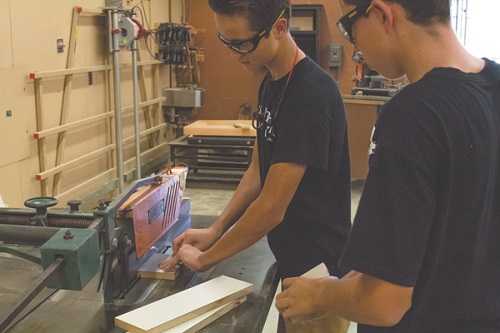Creative Minds at Work
September 16, 2015
The word elective brings to mind classes like orchestra, band, and foreign languages, but the arts are not an option many consider when arranging their schedules. Unlike other subjects, art electives have many differing aspects when compared to academic classes. These differences include what factors are taken into consideration when grading, and the assignments students receive, all of which are unique to each individual subject.
Architecture:
Advised and taught by John Jones, students in architecture participate in a wide variety of activities, ranging from drawing blueprints to actually building physical models. They are separated into two categories, the advanced students and the beginners. Students who just started the class are often given paperwork or instructed how to draw in order to help familiarize them with the intricacies of architecture. Once they have been acquainted with the basics, they can then begin to construct three dimensional models.
Those who are in the advanced group have the privilege of deciding what they want to work on themselves. One student designed a bionic hand, while another built a large scale model of the interior and exterior of a house. When putting together a model, most students tend to finish their products at home.
Jones grades students based on the quality and quantity of their projects. The larger the scale, the more likely a student is to receive a better grade, due to it being harder to accomplish. Of course, quality counts for a lot too. The attention to detail and precision of their measurements are also taken into consideration. The class receives frequent visits from Lylynn Villafuerte, a DBHS alumni and former architecture student. She helps out the advanced students and assists in teaching them what they need to know.
“This class set the foundation for my career, allowing me to be ahead of other students when I began attending USC,” Villafuerte said.
Woodshop:
Each project assigned by woodshop teacher Sam Jacoby aims to encompass as many woodworking skills as possible. For example, one of the first things new students do is build a box, breaking down every component of its structure through planning, drawing, and building.
Those students who have taken the class for more than a year are part of an advanced curriculum. They are taught much more than how to cut, measure, and construct. The advanced students know how to wire electrical outlets, set tile, design house frames, and understand the details of installing plumbing and roofing.
Within the classroom, there are many different machines and saws used for cutting wood, and some of them are taller than a person. The size of Jacoby’s classes are also greatly varied, ranging from twenty-six students in one period, to two in another.
Introduction to 3D-Design:
Though many assume Introduction to 3D-Design is a single class, it’s actually a new course that encompasses both ceramics and jewelry design.
3D-Design is taught jointly by art teachers Coleen Gee and Vianney Hwang. As it is an introductory class, there are no advanced students; students who attended 3D-Design have the opportunity to move on to AP Studio Art or IB Visual Arts, continuing to use the knowledge they gained in the introduction class to create a three dimensional portfolio.
The class is separated into three sections with Gee in charge of fourth and fifth period, while Hwang, who joined the DBHS staff this year, teaches sixth period.
There is a great diversity of materials the students work with, such as paper Mache and clay for ceramics, along with sterling silver and crystals for jewelry design. The availability of all these workable items is mostly dependent on parental donations.
Even though they’re given a general idea for the assignments they work on, students have the freedom to determine how to handle and design the specifics of their project. Themes, details, and design are chosen by the students themselves.
“I’ve been creating art my whole life and I have passion with recognizing artistic talent in others.” Hwang said.









